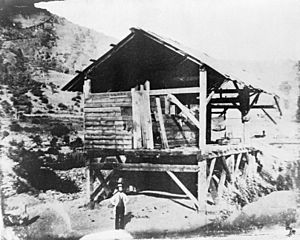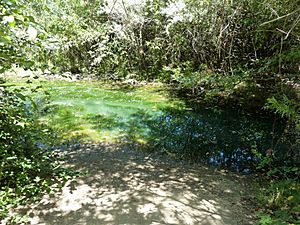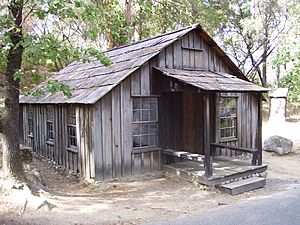James Wilson Marshall facts for kids
Quick facts for kids
James Wilson Marshall
|
|
|---|---|

James Marshall, 1 year before death
|
|
| Born | October 10th, 1810 Hopewell Township, New Jersey
|
| Died | August 5th, 1885 Kelsey, California
|
James Wilson Marshall (October 8, 1810 – August 10, 1885) was an American carpenter and sawmill operator. He is famous for finding gold in Coloma, California, on January 24, 1848. This amazing discovery started the California Gold Rush.
Contents
Early Life and Moving West
James Wilson Marshall was born on October 8, 1810, in Hopewell Township, New Jersey. He was the oldest of four children. In 1816, his family moved to Lambertville.
In 1834, James left New Jersey and traveled west. He spent time in Indiana and Illinois. By 1844, he settled in Missouri and started farming. While there, he became sick with malaria. His doctor told him to move to a healthier place.
In 1845, Marshall joined a group heading west. He arrived in Oregon in the spring. Later that year, he traveled south to California. He reached Sutter's Fort, an important farming settlement, in July.
Working with John Sutter
At this time, California was part of Mexico. John Sutter was the leader of Sutter's Fort. He hired Marshall to help with carpentry work. Marshall also bought land and started farming again.
Soon after, the Mexican–American War began in May 1846. Marshall joined the California Battalion. When he returned to his ranch in 1847, he found his cattle were gone. Because he lost his animals, Marshall also lost his land.
Building Sutter's Mill
Marshall then partnered with John Sutter to build a sawmill. Marshall was in charge of building and running the mill. In return, he would get a share of the lumber.
Marshall searched for a good spot. He chose Coloma, California, about 40 miles (64 km) from Sutter's Fort on the American River. Construction began in August. His team included local Native Americans and former soldiers.
Work continued into January 1848. They found that the ditch for the waterwheel, called the tailrace, was too small. Marshall decided to use the river's force to make the ditch bigger. This work could only be done at night. Each morning, Marshall checked the progress.
The Gold Discovery
On the morning of January 24, 1848, Marshall was checking the channel below the mill. He saw some shiny specks. He later described it:
I picked up one or two pieces and looked at them closely. I knew a bit about minerals. Only two things looked like this: iron, which is bright but breaks easily; and gold, which is bright but can be shaped. I tried to smash it between two rocks. It flattened out but did not break. I then gathered a few pieces and went to Mr. Scott, who was building the mill wheel. I held the pieces and said, "I have found it."
"What is it?" Scott asked.
"Gold," I replied.
"Oh! no," Scott said, "That can't be."
I answered, "I know it's nothing else."—James W. Marshall
Other workers tested the metal. They boiled it in soap and hammered it. It was indeed gold! Marshall allowed his crew to look for gold in their free time.
Four days later, Marshall returned to Sutter's Fort. The war had ended, and California was becoming part of America. Marshall told Sutter about his discovery. Sutter tested the gold and confirmed it was "of the finest quality," almost pure.
Impact of the Discovery
News of the gold discovery quickly spread around the world. For Marshall, the immediate effects were not good. His sawmill failed because everyone left to search for gold. Soon, many gold seekers arrived and forced him off his land. Marshall left the area.
Marshall returned to Coloma in 1857. He had some success in the 1860s with a vineyard (a farm that grows grapes for wine). But this business also failed due to higher taxes and more competition. He tried to find gold again, hoping for better luck.
He became a partner in a gold mine near Kelsey, California. However, the mine did not produce any gold, and Marshall became very poor. In 1872, the California State Legislature gave him money each year for two years. This was to honor his important role in California's history. The payments were renewed in 1874 and 1876 but stopped in 1878. Marshall ended up living in a small cabin with no money.
Later Life and Legacy
James Marshall died in Kelsey on August 10, 1885. After his death, a group called the Native Sons of the Golden West felt that the "Discoverer of Gold" deserved a monument.
In May 1890, five years after Marshall's death, this group successfully asked the State Legislature for money. They received $9,000 to build a monument and tomb. This was the first monument of its kind in California. A statue of Marshall stands on top of the monument. It points to the exact spot where he found gold in 1848.
See also
 In Spanish: James W. Marshall para niños
In Spanish: James W. Marshall para niños




